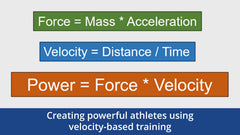Creating Powerful Athletes Using Velocity-Based Training
BY NUNZIO SIGNORE, BA, CSCS, OWNER OF ROCKLAND PEAK PERFORMANCE AND AUTHOR OF VELOCITY-BASED TRAINING
SEPTEMBER 2021

When I first started training I, like many others believed that if we just keep improving absolute strength, our athletes will continue to get bigger, faster, and stronger. Fast forward many years later, and I can tell you with a great degree of confidence (and experience) that most metrics crucial to sport such as speed, explosive ability, and change of direction can only be improved for about the first two years by simply increasing absolute strength, as in getting stronger, by utilizing big compound lifts under high load.
Reverse Lunge @ 85% 1RM or .40-.50 m/s
Diminishing Returns
However, after that, more advanced athletes can experience what is known as “diminishing returns”, at which point simply increasing loads linearly will no longer create the correct adaptation to improve power and speed. As a matter of fact , I've seen gains decrease in athletes when a different type of strength needs to be introduced. At this point, we need to look to increase RFD by giving the athlete more of what they need if we want them to experience adequate transfer to the field or court. Thus, the need for special strength zones.
The Special Strength Zones

Completing the Power Equation using VBT
Most sports are explosive where things happen in milliseconds, thus power is king. The simplified equation for power is:

Which basically means how much force did you generate and how fast is that force moving.
Different Strokes for Different Folks
Different sports as well as different types of athletes may need more of one side than the other (force or velocity) to create the best type of power to excel at their sport. For example, an offensive lineman who is constantly fighting off 300 lbs. of resistance against him all day may need to live a little more on the force side of the power equation. While a baseball player who has only milliseconds to make a decision will generally live on the velocity side a bit more.

In other words, we have to impose the proper demand on the body to get the specific adaptation we are looking for to best complete the power equation. This is known as the SAID principle (Specific Adaptation of Imposed Demands). Whether we are monitoring bar speeds with velocity-based training (VBT) or the traditional percentage of 1RM method, we know that if we want to be able to develop individual traits, we have to look at the strength zones. These are approximate ranges that work great when training in groups, but each individual can and will lie somewhere in between.
- Absolute Strength - < .5 m/s (85-100% of 1RM)
- Accelerative Strength - .5-.75 m/s (around 60-80% of 1RM)
- Strength Speed - .75-1.0 m/s (40-60% of 1RM)
- Speed-Strength - 1.0-1.3 m/s. ( 20-40% of 1RM)
Using bar speeds (velocities) that correspond to the % of the 1RM desired allows you to better “carve out” the load you are utilizing, rather than hoping to be lucky that it was the correct load on that or any other given day. These gains or losses in bar speed can let us know if the athlete is getting stronger (bar speed goes up) or, the athlete is experiencing residual fatigue from training stress or other stressors such as poor sleep, school or relationship stress, etc. This is called “auto-regulation and is another valuable tool that VBT can be used to calculate training readiness on a daily basis. But that’s another article all together.
Get to Know the Athlete in Front of You
I’ve noticed over the years that the guys with the highest type-2 fiber makeup seem to benefit most from small volumes of high-intensity, high-velocity work. They do however need longer and / or more frequent rests to prevent over-training. 60-70 %1RM (approx. .50-.70 m/s) seems to be the perfect range for combining force production with velocity (bar speed).
Trap Bar Deadlifts at 60-70% 1RM or .60 m/s
At the opposite end are our “velocity-deficient” athletes, these are the guys who are high type-1 fiber. They just get better with every attempt, and it seems like they don’t start to even get warmed when pl;aying their sport up the end of the 1st period, quarter or inning. These guys seem to benefit more in the late off-season from improving the contractile properties of the muscle by working at lighter loads 40-60% 1RM (approx. 75-1,0 m/s). In addition, utilizing band assistance on the big lifts to help them get out of the hole quicker can be a game-changer.
Band-Assisted Split Squats
Summary
Every zone is associated with a specific bar and body speed (velocity) and/or a percentage of an athlete’s 1RM and thus produces a different stimulus and corresponding performance adaptations that are exclusive to the zone itself. This better enables us to monitor an athlete’s associated velocities and focus on the trait the athlete is trying to develop to help best complete the power equation for that specific athlete for their specific sport. For more information on using velocity -based training you can check out my book from Human Kinetics-“Velocity-based training: Using technology to improve performance”.
Reference:
Velocity-based training: Using technology to improve performance by Nunzio Signore ©Human Kinetics, 2021

Latest Posts
- A Guide for Fitness Professionals: Dr. Barbara A. Bushman on Fitness Professional’s Handbook, Eighth Edition
- Single-leg vs. double-leg training for athleticism
- Fountain of youth for athleticism: Lifting, sprinting, or jumping?
- Cause-and-effect connection between physical activity and specific outcomes
- The science of getting stronger without weights
- Periodization: What It Is and How It Relates to Planning and Programming


